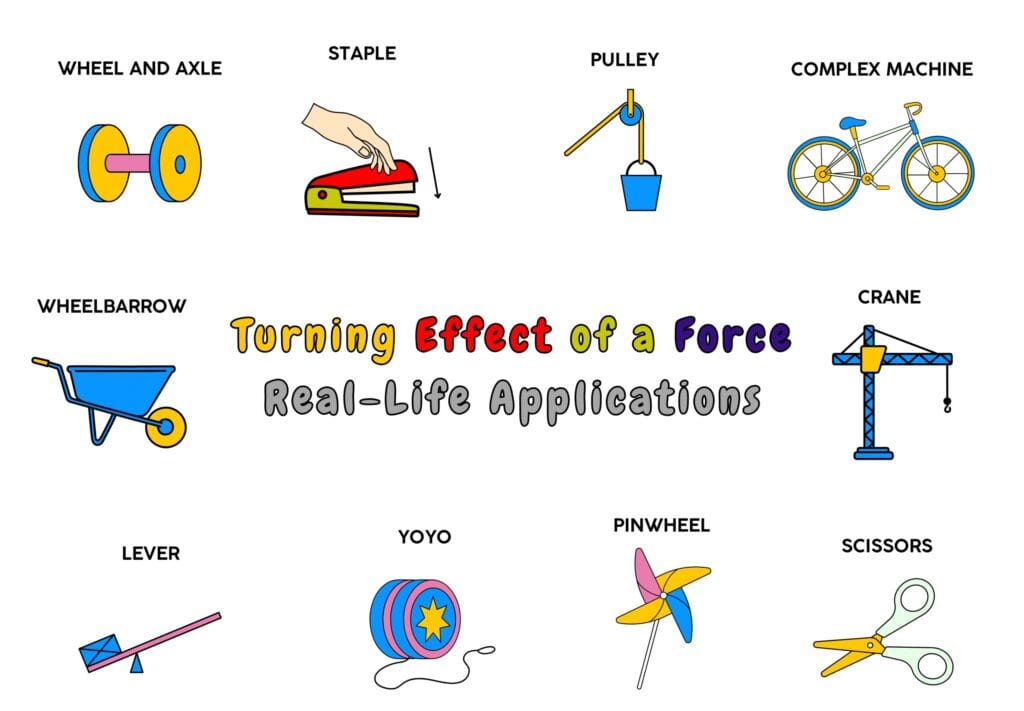Explore “What is the turning effect of force in physics?” and find out how it influences the world around us!
Table of Contents
Introduction
The turning effect of a force is a fundamental concept in physics and mechanics. It explains how forces cause objects to rotate or pivot about a point or axis. This effect is quantifiable through the concepts of moment and torque. The concept, turning effect, is essential for understanding both static and dynamic systems around us.
Whether you are a student, an engineer, or a curious learner, mastering the turning effect of force means equipping yourself with the tools that will help you to understand and optimise the mechanics of rotation.
What Is the Turning Effect of a Force?
The turning effect of a force occurs when a force is applied perpendicularly to an object in a manner that causes it to rotate around a specific point or axis.
![]()
Turning effect of force is a derived and a vector quantity, and measured in the units of newton-meters (N.m).

Distinct Effect of Turning Effect | Moment vs. Torque
As stated earlier, turning effect is studied in both static and dynamic systems like bridges (a static system), turbines (a dynamic system), etc. This phenomenon plays a key role in both everyday mechanics, such as opening doors, and complex engineering systems, like engine design.
Note, the turning effect can be described either as moment or torque based on the effect produced. While the terms are closely related and have the same physics behind them, they are used in different contexts.
Moment
It refers to the turning effect in static cases, such as balancing beams, levers, or bridges. It involves a rotation of ![]() .
.
For details, click here.
Key Points About Moment
- They determine the rotational equilibrium of objects
- Moments play a central role in designing stable structures.
- In practical scenarios, moments are used to calculate the effectiveness of levers and other mechanical tools.
Torque
It applies to rotational systems, such as spinning wheels, gears, and engines. Unlike moment, there is a complete rotation of ![]()
For details, click here.
Key Points About Torque
- It defines the ability of a force to produce angular acceleration.
- Torque is essential in dynamic systems like engines and machinery.
- Engineers and physicists use torque to optimise the performance of rotating systems.
How to Distinguish between Moment and Torque?
Both moment and torque are the turning effects and share the same formula, but their distinction lies in their application.
Applications of the Turning Effect of Forces
1. Everyday Mechanics
- Using a Wrench: The torque helps tighten or loosen bolts by applying rotational force.
- Opening a Door: The force applied to the door handle creates a moment about its hinges.
2. Engineering Systems
- Bridge Design: Moments are used to ensure that the bridge remain stable under various load conditions.
- Automobiles: Torque plays a crucial role in the performance (efficiency) of engines and drivetrain systems.
3. Industrial Applications
- Machinery: Rotational systems, like conveyors, in factories rely on torque for efficient operation.
- Crane Arm: The arm of a crane carries or shifts a load from one place to another and rotates about its pivot..
Conclusion
The turning effect of a force is an important concept that links static and dynamic systems. It tells how force acts in a rotational or circulatory system.
Turning effect of forces (moments and torque) provide a framework to analyse and design systems that rely on rotational mechanics. Understanding their differences and applications enables us to solve real-world problems, from simple tasks like opening doors to complex engineering challenges.
Frequently Asked Questions (FAQs)
What is the turning effect of force in physics?
The turning effect of force refers to the phenomenon where a force applied to an object causes it to rotate around a specific point or axis. This is often described using the concepts of moment and torque.
What is the difference between moment and torque?
While both moment and torque describe the turning effect of a force, moment typically refers to static systems, such as balancing beams, while torque is used for dynamic systems, such as rotating engines.
What are some everyday examples of the turning effect of force?
Examples include opening a door, where force creates a moment to rotate the door on its hinges, and using a wrench, where torque is applied to tighten or loosen bolts.
How is the turning effect of force quantified?
It is quantified using the formula ![]() from the axis of rotation.
from the axis of rotation.
What are the key applications of the moment in engineering?
The moment is crucial for ensuring the stability of structures, such as bridges and beams, by calculating rotational equilibrium under various loads.
Why is torque important in machinery?
Torque determines the ability of a force to produce angular acceleration, making it vital for the efficient operation of engines, gears, and other rotational systems.
What is the role of torque in wind turbines?
The torque generated by wind forces drives the rotation of turbine blades, converting kinetic energy into mechanical energy for electricity generation.
How do engineers use the turning effect of force in design?
Engineers use moments to design stable structures and torque to optimise the performance of rotational systems in automobiles, machinery, and industrial equipment.
Can moment and torque be calculated using the same formula?
Yes, the formula ![]() from Pivot applies to both. The distinction lies in their application—static systems for moments and dynamic systems for torque.
from Pivot applies to both. The distinction lies in their application—static systems for moments and dynamic systems for torque.
What is the importance of understanding the turning effect of force?
Mastering this concept allows us to analyse and solve real-world problems involving rotational mechanics, from simple tasks like using tools to complex challenges in engineering and industry.
